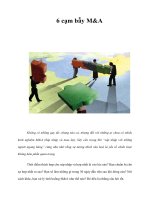Tài liệu Vietnam-Netherlands Programme for M.A. in Development Economics pdf
Bạn đang xem bản rút gọn của tài liệu. Xem và tải ngay bản đầy đủ của tài liệu tại đây (82.39 KB, 25 trang )
Vietnam-Netherlands Programme
for M.A. in Development Economics
Course:
Microeconomics
Pindyck & Rubinfeld (2000)
By
Nguyen Van Phuc
Spring 2006
Chapter 1
Preliminaries
What is Economics?
No unique concept
Conventional concept: Economics is a
social science that studies the allocation
of scare resources to competing uses in
order to maximize the benefit of
individuals, organizations and economy.
A different perspective: Economics as a
science studying markets (James
Buchanan).
Chapter 1: Preliminaries
Slide 3
Preliminaries
Starting point of economics: Universal law
of scarcity
Definition of a scarce resource: at zero
price, demand exceeds supply
Law of scarcity: Conflict between unlimited
human wants and their limited resources
Consequence of scarcity: Man must choose
between wants and resource allocation
Chapter 1: Preliminaries
Slide 4
Basic Questions of
Economics
What to produce?
How?
How much?
For whom?
Chapter 1: Preliminaries
Slide 5
Preliminaries
Microeconomics deals with:
Behavior of individual units
When Consuming
•
How we choose what to buy
When Producing
•
How we choose what to produce
Chapter 1: Preliminaries
Slide 6
Preliminaries
Macroeconomics deals with:
Analysis of aggregate issues:
Economic growth
Inflation
Unemployment
Chapter 1: Preliminaries
Slide 7
Preliminaries
The Linkage Between Micro and Macroeconomics
Microeconomics is the foundation of
macroeconomic analysis
Chapter 1: Preliminaries
Slide 8
Theories and Models
Microeconomic Analysis
Theories are used to explain observed
phenomena in terms of a set of basic rules
and assumptions.
For example
The Theory of the Firm
The Theory of Consumer Behavior
Chapter 1: Preliminaries
Slide 9
Theories and Models
Microeconomic Analysis
Models:
a mathematical representation of a
theory used to make a prediction.
Chapter 1: Preliminaries
Slide 10
Theories and Models
Microeconomic Analysis
Validating a Theory
The validity of a theory is determined by
the quality of its prediction, given the
assumptions.
Chapter 1: Preliminaries
Slide 11
Theories and Models
Microeconomic Analysis
Evolving the Theory
Testing and refining theories is central to
the development of the science of
economics.
Chapter 1: Preliminaries
Slide 12
Positive Versus
Normative Analysis
Positive Analysis
Positive analysis is the use of theories and
models to predict the impact of a choice.
For example:
What will be the impact of an import
quota on foreign cars?
What will be the impact of an increase in
the gasoline excise tax?
Chapter 1: Preliminaries
Slide 13
Positive versus
Normative Analysis
Normative Analysis
Normative analysis addresses issues from
the perspective of “What ought to be?”
For example:
Consider the equity and efficiency tradeoff of an increase in the gasoline excise
tax versus import restriction on foreign
oil.
Chapter 1: Preliminaries
Slide 14
What is a Market?
Market: Collection of buyers and sellers
that, through their actual or potential
interactions, determine the price of a
product or set of products.
Extent of a market:
Geography
Product range
Chapter 1: Preliminaries
Slide 15
What is a Market?
Competitive vs. Noncompetitive Markets
Competitive Markets
Because of the large number of buyers
and sellers, no individual buyer or seller
can influence the price.
Example: Most agricultural markets
Chapter 1: Preliminaries
Slide 16
What is a Market?
Competitive vs. Noncompetitive Markets
Noncompetitive Markets
Markets where individual producers can
influence the price.
Example: OPEC
Chapter 1: Preliminaries
Slide 17
What is a Market?
Market Price
Competitive markets establish one price.
Noncompetitive markets may set many
prices for the same product.
Chapter 1: Preliminaries
Slide 18
Real Versus Nominal Prices
Nominal price is the absolute or current
dollar price of a good or service when it
is sold.
Real price is the price relative to an
aggregate measure of prices or
constant dollar price.
Chapter 1: Preliminaries
Slide 19
Real Versus Nominal Prices
The Consumer Price Index (CPI) is an
aggregate measure.
Real prices are emphasized to permit the
analysis of relative prices.
Chapter 1: Preliminaries
Slide 20
Real Versus Nominal Prices
Calculating Real Prices
Real Price =
(base year = 100)
CPIbase year
CPIcurrent year
Chapter 1: Preliminaries
x Nominal Pricecurrent year
Slide 21
Summary
Microeconomics is concerned with the
decisions made by small economic
units.
Microeconomics relies heavily on the
use of theory and models.
Chapter 1: Preliminaries
Slide 22
Summary
Positive and normative issues.
A market refers to a collection of buyers
and sellers who interact and to the
possibility for sales and purchases that
results from that interaction.
Chapter 1: Preliminaries
Slide 23
Summary
The market price is established by the
interaction of buyers and sellers.
A market’s geographic boundaries and
range of products must be defined.
To eliminate the effects of inflation we
measure real prices, rather than
nominal prices.
Chapter 1: Preliminaries
Slide 24
End of Chapter 1









